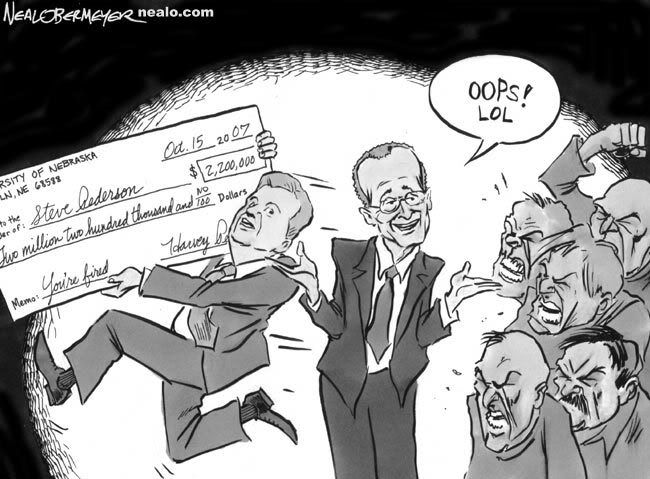 I chose to analyze a political cartoon by Neal Obermeyer. In this cartoon we are shown many different images. We are shown Harvey Perlman, the University of Nebraska-Lincoln chancellor, in the center of the cartoon, shrugging his shoulders and with an oblivious expression on his face, saying, “Oops. Lol.” To his left, we are shown Steve Pederson, the University of Nebraska’s former Athletic Director (AD). Pederson is pictured running away with an enormous check. On the check we see how much it’s worth, what it’s being given to Pederson for, and who gave it to him. Another image that we see is that of angry people, presumably Nebraska football fans or the booster club, standing directly to the right of Perlman. We can assume that they are angry because their faces appear to be slightly distorted and their expressions are twisted into menacing sneers. One other thing that is important to note is that Perlman and Pederson appear to be in some sort of spotlight which is most likely there just to show that they are the center of attention.
I chose to analyze a political cartoon by Neal Obermeyer. In this cartoon we are shown many different images. We are shown Harvey Perlman, the University of Nebraska-Lincoln chancellor, in the center of the cartoon, shrugging his shoulders and with an oblivious expression on his face, saying, “Oops. Lol.” To his left, we are shown Steve Pederson, the University of Nebraska’s former Athletic Director (AD). Pederson is pictured running away with an enormous check. On the check we see how much it’s worth, what it’s being given to Pederson for, and who gave it to him. Another image that we see is that of angry people, presumably Nebraska football fans or the booster club, standing directly to the right of Perlman. We can assume that they are angry because their faces appear to be slightly distorted and their expressions are twisted into menacing sneers. One other thing that is important to note is that Perlman and Pederson appear to be in some sort of spotlight which is most likely there just to show that they are the center of attention.This cartoon deals with the recent firing of Steve Pederson. In the eyes of
 Chancellor Harvey
Chancellor Harvey Perlman and many Nebraska Cornhusker fans, Steve Pederson was not doing a good enough job in his position. The problem was that earlier this year, the University gave Pederson a five-year contract extension so the University had to buy out his contract at $2,200,000 in order to fire him. The political cartoon is saying that Harvey Perlman threw away all of that money. First, he gave Pederson a contract extension and then, a mere three months later, Perlman decided to fire him.
Perlman and many Nebraska Cornhusker fans, Steve Pederson was not doing a good enough job in his position. The problem was that earlier this year, the University gave Pederson a five-year contract extension so the University had to buy out his contract at $2,200,000 in order to fire him. The political cartoon is saying that Harvey Perlman threw away all of that money. First, he gave Pederson a contract extension and then, a mere three months later, Perlman decided to fire him.I believe that this cartoon is making two arguments. One is that Perlman made a really big mistake when he extended Pederson’s contract. Then after he realized it was a mistake, he just shrugged it off with a little “Oops, sorry!” As though throwing away $2.2 million dollars was like spilling your milk at the dinner table. The second argument that I saw made in this article is that Perlman was essentially just letting Steve Pederson run away with $2,200,000.
I really like this cartoon because of the humorous way that it is presented. Presentation is a major factor in determining how effective an argument is. In this political cartoon, Obermeyer uses many rhetorical strategies. Obviously, he uses illustration, this is a drawing, but he uses much more than just that. However, I am only going to focus on one of those strategies: cause and effect. I believe that this is one of the most important strategies that is used in this political cartoon.
Cause produces an effect. This may seem elementary, but it is important that one has this understanding when talking about cause and effect. With that in mind, let’s talk about how cause and effect is used in Obermeyer’s cartoon.
There is more than just one cause in this cartoon. The causes in this cartoon are the actions that UNL Chancellor, Harvey Perlman took in hiring Steve Pederson, giving him a contract extension, firing him, and then having to pay him $2.2 million dollars. All of these actions produce some sort of effect and are therefore qualified as “causes.”
It is important to mention that actions are not strictly causes or effects. They can be both. Some of the causes in this cartoon can also be labeled as effects of another cause. For example, Harvey Perlman hired Steve Pederson. That is the base cause in this cartoon, the foundation for all the other causes. The effect of Perlman’s decision to hire Pederson was that eventually Perlman gave Pederson a contract extension. This cause meant that if Perlman ever wanted to fire Pederson before his contract ran out, Perlman would have to buy out the rest of Pederson’s contract. Three months after he gave Pederson a contract extension, Perlman fired Pederson. This was another cause. The effect of Perlman firing Pederson was that he had to pay him over two million dollars to buy out his contract. This effect is also another cause. This cause produced an effect of angry people, most likely the Boosters and other big money donors, involved with the University of Nebraska. These people are angry because of all the money that Perlman wasted throughout the entire process of hiring and firing Steve Pederson.
There are only three types of rhetorical appeals: logos, pathos, and ethos. Logos deals with rational arguments and reason. Pathos is more along the lines of an appeal to the emotions of and individual. Ethos is an appeal to authority or character.
Although all of these three appeals are present in some form or another, I believe that the most important rhetorical appeal that is being used in this political cartoon is pathos. This cartoon contains a lot of humor and looks as if it is trying very hard to appeal to the emotions of people. It is using humor to connect with the reader. It does that in a few different ways. The first way is by having Harvey Perlman say “Oops. LOL” when he’s talking about firing Steve Pederson. No one, especially a university chancellor, would ever talk like that at any time, and definitely not about something as serious as firing a high-profile staff member and having to pay him $2.2 million. Really no one ever uses “lol” when they’re talking. Lol just means “laugh out loud” and is generally used on the internet or in text messages. It is used to convey to the reader that the speaker finds something to be humorous. However, in the cartoon Obermeyer does this to make it seem like Perlman really didn’t care at all about firing Pederson and was just blowing the whole issue off.
Another humorous element in this cartoon is Steve Pederson running away with a huge check. This check is ridiculously large and brings a lot of attention to itself. I believe that Obermeyer is trying to show us something through this check and that’s why he made it as abnormally large
 as he did. I believe that through the size of the check, Obermeyer is trying to show the readers just how much is being wasted on firing Pederson. All that said, this image gives the reader the impression that Pederson is taking his check and running to the bank as fast as he can so that nobody can stop him. This is humorous because it makes it look like Steve Pederson is a criminal who just stole a lot of money and is fleeing to Zurich to deposit his riches before he is apprehended.
as he did. I believe that through the size of the check, Obermeyer is trying to show the readers just how much is being wasted on firing Pederson. All that said, this image gives the reader the impression that Pederson is taking his check and running to the bank as fast as he can so that nobody can stop him. This is humorous because it makes it look like Steve Pederson is a criminal who just stole a lot of money and is fleeing to Zurich to deposit his riches before he is apprehended. In my opinion this cartoon employed some very useful rhetorical strategies and appeals. I thought that the way that Obermeyer utilized pathos was exceptional. It was done in such a way so that it was humorous and yet at the same time meaningful, which is a very important trait in any argument. I also enjoyed the strategy of cause and effect that Obermeyer used. It caught my attention and also caused me to think about all of the different actions that took place in order for this cartoon to be what it was. I really admired this cartoon and thought that it made an outstanding argument.
No comments:
Post a Comment